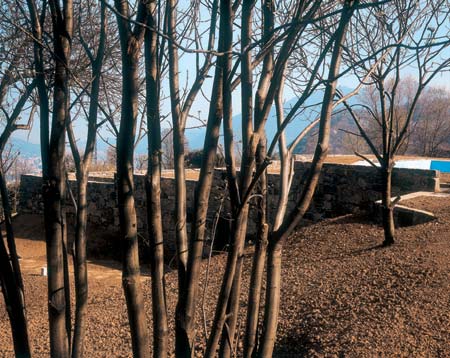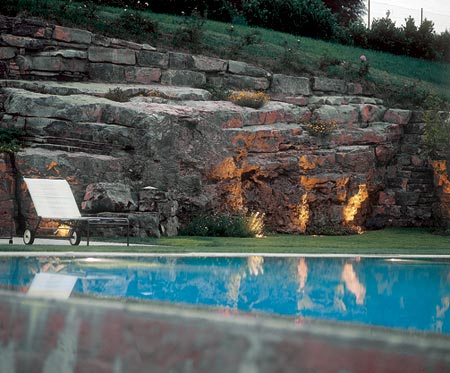23 Febbraio 2010
English
Swimming-pool in the Seriana Valley(1995 – 1996)
ARCHEA*

The construction of an outdoor swimming-pool in an existing villa represented the chance to remodel the surrounding rocky terrain. “The natural state of the slope suggested need for an artificial buttress as a retaining wall, so as to be able to recoup a little flat ground on which to build a split-level pool. The image of the buttress is evidenced by the presence of a lowered walkway that forms a stone perimeter around the terrace”.1
The swimming-pool complex is composed of two pools – a larger, rectangular, unheated pool, and a smaller heated pool shaped around the contours of the buttress itself. This stone platform, with its sharp-cornered scarped walls, is somewhat reminiscent of the Forte di Belvedere in the city of Florence (which has been the base of the Studio ARCHEA since 1988).
The excavation of the site, intended to create a coplanar terrace, revealed the presence of a seam of rock which was immediately utilised to provide stone for the construction of the complex itself. This brown stone with clear yellowish streaks was employed in the form of large, roughly-hewn ashlars to create a strong fortress-like wall – almost a cyclopean work of substruction – displaying rudimentary, archaic-style facing, dressed here and there only in order to facilitate laying. The mortar joints play a largely insignificant role in a wall of such massive blocks of stone, laid closely to one another as a result of their sheer weight.

[photogallery]piscina_vseriana_album[/photogallery]
The architecture amplifies the force of the surrounding mountains and blends in with the stony nature of the site itself. The bulwark is attached to the mountain at the jagged face of the fault, which is where the stone is quarried, and as such is left, complete with vegetation, to form the natural backdrop to the swimming-pool. This blend of the natural and the artificial also features a series of winding paths, of steps carved out of the rock itself, and of ancillary rooms dug out of the slope.
The roughness of the stone surrounding the pool area is replaced by smooth travertine at the poolside itself: highlighted by the light hues of the sedimentary stone surrounds, the presence of water in the pool resembles that of a spring rising up from the bowels of the mountain, a protected source of an indestructible architecture dominating the surrounding landscape.
Davide Turrini
Notes
* The re-edited essay has been taken out from the volume by Alfonso Acocella, Stone architecture. Ancient and modern constructive skills, Milano, Skira-Lucense, 2006, pp. 624.
1 Rebecca Innocenti and Francesca Privitera (eds.), Studio Archea, Florence, Alinea, 1997, p.55.
